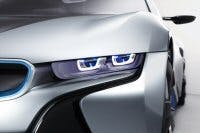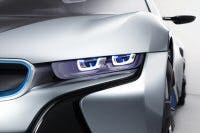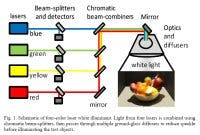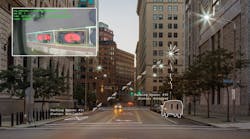Intuitively, one would not expect that lasers would be an ideal light source. One reason is the extremely narrow spot size: imagine trying to illuminate a kitchen surface with a white version of a laser pointer. Obviously, this can be addressed with a suitable optical system (see Fig. 2, which shows Sandia’s experimental setup). The same applies to optical safety issues caused by the intense laser beams.
Another factor is the extremely narrow linewidth of the laser sources. Four very narrow peaks at red, blue, green and yellow wavelengths would not be expected to result in good color rendering, compared to much broader peaks from LED sources, or the continuous spectrum of sunlight.
“Before these tests, our research in this direction was stopped before it could get started,” said Sandia researcher Jeff Tsao, who proposed the comparative experiment. “The typical response was, ‘Are you kidding? The color rendering quality of white light produced by diode lasers would be terrible.’ So finally it seemed like, in order to go further, one really had to answer this very basic question first.”
More specifically, there was a statistically significant preference for the diode-laser-based white light over the warm and cool LED-based white light, but no statistically significant preference between the diode-laser-based and either the neutral LED-based or incandescent white light.
The results don’t go much beyond suggesting that lasers shouldn’t be ruled out as a potential illumination source. There is no immediate threat to LED-based lighting from a four-laser system, since the performance of different-colored laser diodes varies widely. In a Sandia press release, Tsao suggested that blue and red diode lasers might be used in combination with yellow and green LEDs.
Lasers in cars
Another approach, which is the one taken by BMW, is to use blue lasers to illuminate a remote phosphor system, generating white light (Fig. 3). The idea of laser beams shooting out from car headlights could create some concerns with optical safety, but of course the optical system prevents direct viewing of the laser source. “Safety is a key consideration in the development of laser lighting for use in passenger cars. For BMW, the complete eye safety of this technology for all road users and its complete reliability in day-to-day use have top priority,” said a BMW press release.
Size is also a factor, since laser diodes have a length of just ten microns while LEDs typically measure 1x1 mm. Even so, BMW says that its engineers have no plans to radically reduce the size of the headlights. Instead, the thinking is that the headlights would retain their conventional surface-area dimensions and so continue to play an important role in the styling of a BMW, while the size advantages could be used to reduce the depth of the headlight unit, and so open up new possibilities for headlight positioning and body styling.
LEDs and laser diodes have similar light-generating structures, but while the LED relies on spontaneous emission of light, a laser diode contains mirror structures that stimulate emission within the structure and amplify the amount of light (hence the acronym laser, which stands for Light Amplification by Stimulated Emission of Radiation).
According to Sandia, one advantage of lasers over LEDs is that the efficiency of lasers actually increases at higher currents, compared with the efficiency “droop” that is a common feature of LEDs.
Sandia publication details
Sandia’s paper was published in a special issue of Optics Express entitled “Optics in LEDs for Lighting.” The full citation for the paper is:
A. Neumann, J. J. Wierer, W. Davis, Y. Ohno, S. R. J. Brueck, and J.Y. Tsao, "Four-color laser white illuminant demonstrating high color-rendering quality." Opt. Express 19, A982-A990 (2011).





![An installer uses a cell phone to configure a connected lighting system in a Next Generation Lighting Systems (NGLS) living lab. [Photo credit: Image courtesy of Pacific Northwest National Laboratory (PNNL) and NGLS.] An installer uses a cell phone to configure a connected lighting system in a Next Generation Lighting Systems (NGLS) living lab. [Photo credit: Image courtesy of Pacific Northwest National Laboratory (PNNL) and NGLS.]](https://img.ledsmagazine.com/files/base/ebm/leds/image/2020/06/NGLS_Photo_2.5ed693de53fa2.png?auto=format,compress&fit=crop&q=45&h=139&height=139&w=250&width=250)


